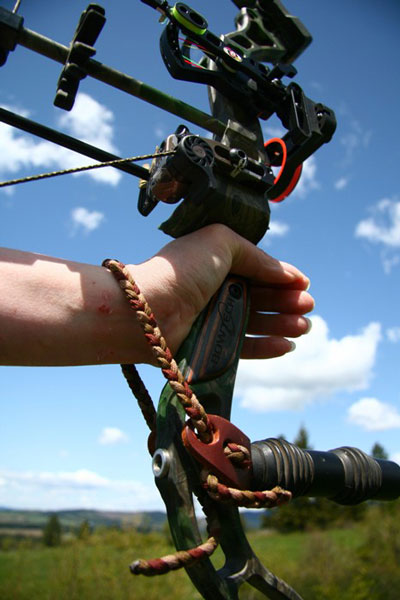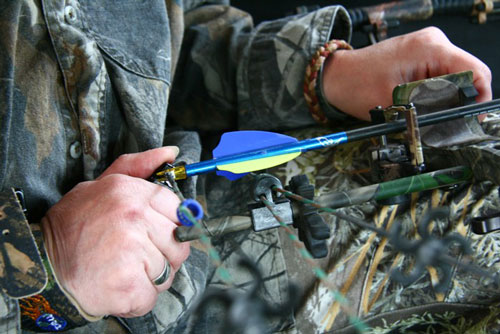 If it ain’t broke, why fix it? This is an automatic response from many bowhunters coaxed to change, especially those who have enjoyed a steady string of success through many seasons. I’m one of those people—I absolutely hate changing computer operating systems, like my ancient truck just fine, and am highly resistant to change when it comes to a trusted bowhunting rig.
If it ain’t broke, why fix it? This is an automatic response from many bowhunters coaxed to change, especially those who have enjoyed a steady string of success through many seasons. I’m one of those people—I absolutely hate changing computer operating systems, like my ancient truck just fine, and am highly resistant to change when it comes to a trusted bowhunting rig.
Still, I have to admit, archery equipment is improving every season. Because work and family responsibilities make hunting time more precious every year, there really is something to be gained by investing in new archery accessories, which often promise more accuracy and improved shooting success from any bow. Here are five easy fixes to bring any bow up to speed.
New Rest
If you shoot a release, you really owe it to yourself to try a drop-away arrow rest. Why? Mostly freedom from the limitations of old-style launcher rests, but also added bowhunting accuracy from a couple different fronts. Foremost to my mind, drop-away rests allow more aggressive helical or fletching offset to your hunting arrows without worry of fletching contact with rest arms. Old-style launcher rests limit fletching attitude because they force you to send at least one vane between launcher arms, limiting the amount of helical you can add. Increased fletching twist gives your arrow more spin in flight, automatically improving broadhead accuracy. Also, because the arms of a drop-away rest fall away before fletchings arrive, drop-aways also offer forgiveness. The arrow spends less time on the rest arms—and less time for you to flinch or bumble the shot off mark.
Improved Grip
 Every archer understands gripping the bow handle during release causes accuracy-robbing torque on release. To alleviate this torque, the smart bowhunter strives to eliminate the natural tendency to clutch or grab the bow on release. Adopting a loose, open-handed grip during the shot also creates better balance before and after release. The obvious solution is a wrist sling combined with the right stabilizer—accessories many bowhunters continue to ignore. A properly adjusted wrist sling (one actually supporting the bow after release) simply alleviates the fear of dropping the bow after release. The proper stabilizer keeps your bow sitting up straight in your hand during all stages of the shot. (Bonus: It also quiets your bow!) The result is less torque and increased accuracy.
Every archer understands gripping the bow handle during release causes accuracy-robbing torque on release. To alleviate this torque, the smart bowhunter strives to eliminate the natural tendency to clutch or grab the bow on release. Adopting a loose, open-handed grip during the shot also creates better balance before and after release. The obvious solution is a wrist sling combined with the right stabilizer—accessories many bowhunters continue to ignore. A properly adjusted wrist sling (one actually supporting the bow after release) simply alleviates the fear of dropping the bow after release. The proper stabilizer keeps your bow sitting up straight in your hand during all stages of the shot. (Bonus: It also quiets your bow!) The result is less torque and increased accuracy.
Brighter Sights
If your eyesight isn’t what it used to be, or trophy game only seems to appear at the last moments of legal shooting light, a brighter fiber optic sight is a great investment toward more confident shooting and increased success. Even during bright daylight, highly visible fiber optic pins allow a smaller-diameter aiming point, obstructing less of the target and offering finer shot placement. Look for models with spooled, aperture-wrapped, or extended fibers to maximize the advantages of this technology. The newest sight designs also make fine adjustments quicker and easier, often without the need for tools.
Better Arrows
I understand times are tough, but most budget-priced arrows don’t offer the highest degree of accuracy possible. Arrows are the vehicles that carry our lethal broadheads to target. Buying quality brands and models with the narrowest straightest tolerances, uniform 360-degree spine ratings (perhaps the most important aspect of all), and tightest matched weight help assure every shot is the best it can be. Sure, the best arrows cost more, sometimes twice as much, but in the big picture, arrows are small potatoes compared to other hunting expenses.
Switch Releases
I ndex-finger releases are an industry standard. Not necessarily because they’re best accuracy-wise, but because most of us started as gun hunters, and they’re convenient and familiar to us. Unfortunately, index-finger release designs make it easy to slip into bad habits, such as trigger punching, which opens doors to debilitating target panic. A simple, yet completely viable option can help alleviate accuracy-robbing habits and give you more control over your shooting: the thumb- (most common) or pinkie-activated (less common) T-handled release. Such designs make a controlled, surprise release easier because instead of posing the trigger finger in anticipation and slapping it home, the design encourages squeezing the entire hand closed to cut the string away. By installing a string loop and leaving the T-handle snapped in place, your release is always ready for action.
ndex-finger releases are an industry standard. Not necessarily because they’re best accuracy-wise, but because most of us started as gun hunters, and they’re convenient and familiar to us. Unfortunately, index-finger release designs make it easy to slip into bad habits, such as trigger punching, which opens doors to debilitating target panic. A simple, yet completely viable option can help alleviate accuracy-robbing habits and give you more control over your shooting: the thumb- (most common) or pinkie-activated (less common) T-handled release. Such designs make a controlled, surprise release easier because instead of posing the trigger finger in anticipation and slapping it home, the design encourages squeezing the entire hand closed to cut the string away. By installing a string loop and leaving the T-handle snapped in place, your release is always ready for action.






